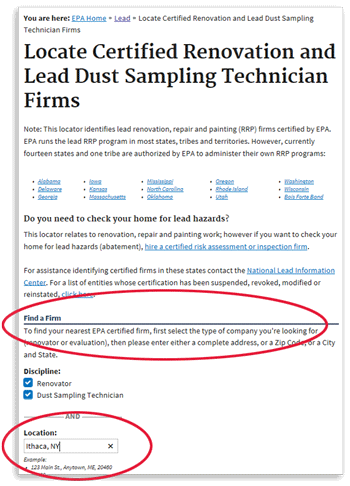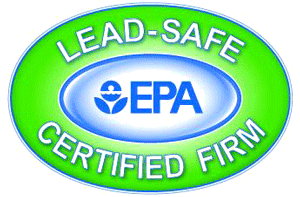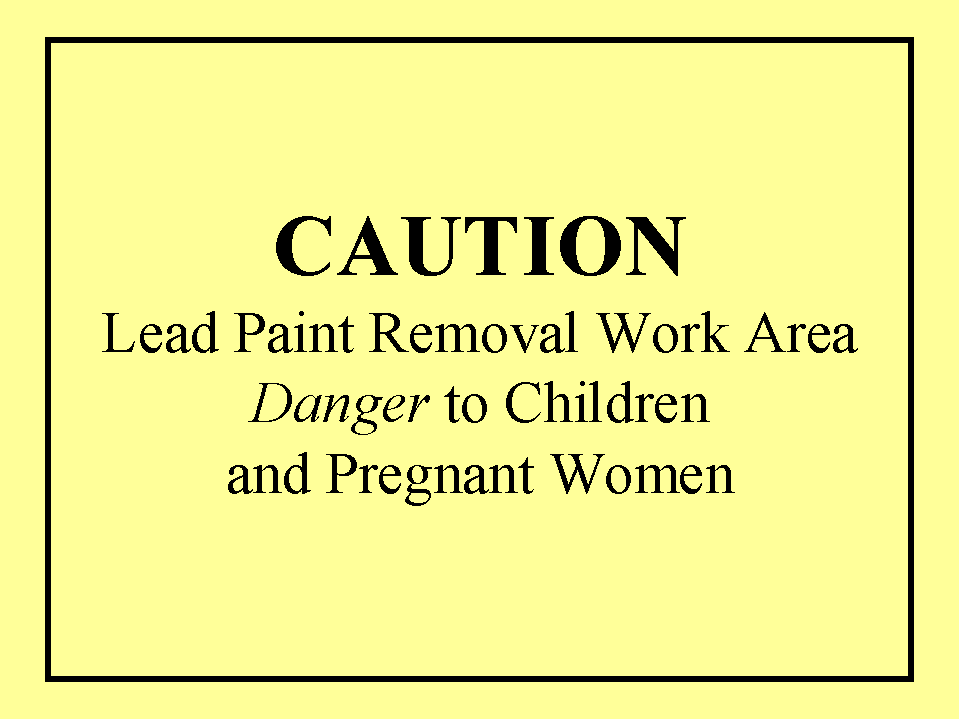• Find a Certified Contractor/ Professional
• EPA Certification Requirements
• Recommendations for Reducing Health Risks
• Links to more info
Find a Certified Professional
 The EPA requires that firms performing renovation, repair, and painting projects that disturb lead-based paint in pre-1978 homes, child care facilities, and schools, be certified by EPA and that they use certified renovators who are trained by EPA-approved training providers to follow lead-safe work practices. The EPA maintains a directory of certified professionals through which you can find the most accurate listing of certified firms.
The EPA requires that firms performing renovation, repair, and painting projects that disturb lead-based paint in pre-1978 homes, child care facilities, and schools, be certified by EPA and that they use certified renovators who are trained by EPA-approved training providers to follow lead-safe work practices. The EPA maintains a directory of certified professionals through which you can find the most accurate listing of certified firms.
EPA Directory
Find EPA RRP certified contractors: Click here for the EPA search page. Scroll down to “Find a Firm”, enter your city or ZIP code in the search box, then enter the mileage radius to refine your search area.
About Contractor Certification
Under the Renovation, Repair and Painting rule, beginning April 22, 2010, contractors performing renovation, repair and painting projects that disturb lead-based paint in homes, child care facilities, and schools built before 1978 must be certified and must follow specific work practices to prevent lead contamination. See below for additional information.
Purpose
To protect workers, building occupants, and the neighboring public from exposure to lead dust.
Background
The Tompkins County Sanitary Code, Article IX states the following:
“No person shall discharge such quantities of air contaminants which may endanger the health of any person. Such discharges shall be controlled using all available technology”.
Lead dust is considered an air contaminant in Tompkins County. Uncontrolled discharge of lead based paint dust may endanger public health and can be considered a violation of Article IX. An example of a violation is grinding or sanding of lead paint in residential areas, which expose neighbors, workers or building occupants to lead dust.
Lead is highly toxic and affects virtually every system of the body. While excessive lead exposure affects everyone, the groups at most risk are fetuses, infants, and children under the age of 6. At low levels, lead’s neurotoxic effects have the greatest impact on children’s developing brains and nervous systems, causing reductions in IQ and attention span, reading and learning disabilities, hyperactivity, and behavioral problems.
New York State Regulation 10NYCRR 67-3 require that any blood tests at or above 10 micrograms per deciliter be reported to the Health Department.
Lead based paints were manufactured for residential use until 1978. Some lead based paints contained as much as 50 percent lead by dry weight. The percentage of exterior paint that was lead-based before 1940 is estimated to be 80%, 1940 to 1959 at 45%, and 1960 to 1979 at 28%.
EPA Certification
Beginning April 22, 2010, contractors performing Renovation, Repair and Painting projects (RRP) that disturb lead-based paint in homes, child care facilities, and schools built before 1978 must be certified and must follow specific work practices to prevent lead contamination.
The requirements apply to Renovation, Repair and Painting (RRP) activities. The rule generally does not apply to minor maintenance or repair activities where less than six square feet of lead-based paint is disturbed in a room or where less then 20 square feet of lead-based paint is disturbed on the exterior, but this does not include window replacement, demolition, or prohibited practices.
 EPA requires that firms performing renovation, repair, and painting projects that disturb lead-based paint in pre-1978 homes, child care facilities and schools be certified by EPA and that they use certified renovators who are trained by EPA-approved training providers to follow lead-safe work practices. Individuals can become certified renovators by taking an eight-hour training course from an EPA-approved training provider. For information visit EPA.gov/lead/getcertified.
EPA requires that firms performing renovation, repair, and painting projects that disturb lead-based paint in pre-1978 homes, child care facilities and schools be certified by EPA and that they use certified renovators who are trained by EPA-approved training providers to follow lead-safe work practices. Individuals can become certified renovators by taking an eight-hour training course from an EPA-approved training provider. For information visit EPA.gov/lead/getcertified.
Find EPA RRP certified contractors: Click here for the EPA search page. Scroll down to “Find a Firm”, enter your city or ZIP code in the search box, then enter the mileage radius to refine your search area.
Recommendations
The Following Recommendations Can Reduce the Health Risks Associated with the Removal of Lead-Based Paint
Testing Painted Surfaces for Lead Prior to Renovation
Painted surfaces should be tested for lead before planning / beginning renovation.
- The best method for testing lead in paint is a portable x-ray fluorescence (XRF) lead paint analyzer backed up by the laboratory analysis of paint chips. This is especially useful when there are many surfaces to be tested.
- Laboratory analysis of paint chips at a New York State certified test lab is an effective method for determining the quantity of lead in paint.
- If an XRF or lab paint chip test cannot be performed, chemical spot-test kits can be used. These kits are often available in paint supply stores. Some of the disadvantages of using these kits are:
1. Insufficient evidence to fully endorse these kits.
2. Results are only for surface layer of paint where the swab is applied.
3. Older lead paint is likely to be hidden under layers of non-lead based paint.
Interpretation of Test Results
If paint contains lead equal to or greater than 5000 ug/g (equal to 0.5 percent, 5000 mg/kg, or 5000 ppm) by weight or 1.0 mg/cm2 by area, it is considered to be lead-based paint under the Lead-Based Paint Poisoning Prevention Act.
- Paint chip samples are usually reported in percent by weight as micrograms per gram (ug/g), milligrams per kilogram (mg/kg), or parts per million (ppm). For example, a sample with 0.2 percent lead may be reported as 2,000 ug/g, 2000 mg/kg, or 2000 ppm.
- XRF test results are reported by area, usually in milligrams per square centimeter (mg/cm2).
Exterior Work Site Preparation
The following should be used as a guide for exterior work site protection:
1. Containment and Barrier System. Lead dust is to be kept to a minimum in the work areas, and is not allowed onto public walkways, streets or neighboring properties.
- Place one layer of plastic on the ground extending 10 feet beyond the perimeter of working surfaces.
- Tape plastic to side of building or use another other anchoring system (no gaps between plastic & building).
- Weight all plastic down with two-by-fours or similar objects.
- Close all windows within 20 feet of working surfaces, including windows of adjacent structures.
- Remove all moveable playground equipment, toys, sandboxes, and similar items to a 20-foot distance from working surfaces. Items that cannot be moved to a 20-foot distance can be sealed with taped plastic sheeting.
2. Security. The work area is to be accessible only by workers, not building occupants or passersby.
- Erect temporary fencing or barrier tape at a 20-foot perimeter around working surfaces (or less if the distance to next building or sidewalk is less than 20 feet).
- If an entryway is within 10 feet of working surfaces, require use of alternative entryway.
- If practical, install vertical containment to prevent exposure. Such containment consists of erecting temporary barrier walls around the work site using materials such as plywood or plastic sheeting.
- Use a locked dumpster, covered truck, or locked room to store debris before disposal.
3. Hazard Notification. 
- Post at least two warning signs (8 ½ x 11 inches) next to
the work area (refer to the example on the right).
4. Weather.
- Do not conduct work if wind speeds are greater than 20 miles per hour.
- Work must stop and cleanup must occur before rain begins.
5. Cleanup.
- Do not leave debris or plastic out overnight if work is not completed.
- Plastic sheeting should be rolled up to contain debris and discarded at the end of each workday.
- Remove all debris from horizontal surfaces (i.e. window wells, porch railings, floors, etc.) by using a HEPA vacuum or wet cleaning.
- Keep all debris in secured area until final disposal.
- Workers should never eat or drink on the construction site.
Recommended Methods to Remove Exterior Lead-based Paint
The recommended lead paint removal/abatement methods, assuming the appropriate containment and worker PPE are used, are as follows:
- HEPA Sander, HEPA Vacuum Blast, HEPA needle gun
- Heat Guns below 1,100º F
- Caustic Paste
- Wet Sanding
- Other methods - off-site stripping, enclosure (plywood; prefab metal; wood, metal and vinyl siding), remove and replace.
The methods that are Not Recommended are as follows:
- Open flame burning or torching (includes propane fueled heat grids).
- Machine grinding or sanding without HEPA local vacuum exhaust tool.
- Uncontained hydroblasting or high pressure wash.
- Abrasive blasting or sandblasting without HEPA local vacuum exhaust tool.
- Heat guns above 1,100º F.
- Methylene Chloride paint removal products.
- Dry Scraping (except for limited surface areas).
The use of any method that results in an uncontrolled discharge of lead based paint dust in a populated area, which may endanger public health, may be considered a violation of Article IX. Work should be planned and carried out to prevent violations; violation can result in penalties of several hundred dollars a day.
Worker Rights and Personal Protection Equipment (PPE).
- Under the OSHA Interim Final Lead in Construction Standard (1926.62) that went into effect on June 3, 1993, all construction workers who may be exposed to lead on the job have the right to personal protection, training, and medical surveillance. For more information contact OSHA: (315) 451-0808; http://www.osha.gov
- A properly fitted half-mask air purifying respirator with HEPA filters are usually adequate for most exposures. Other personal protection equipment required are coveralls with a hood, booties, hard hat, gloves, and face shields or vented goggles.
Additional Resources
For further information on these guidelines and listing of regional New York State certified test laboratories contact:
- Tompkins County Division of Environmental Health, phone (607) 274-6688, or
- Cornell Cooperative Extension of Tompkins County, 615 Willow Avenue, Ithaca, N.Y. 14850-3555, (607) 272-2292.
References:
1996. HUD Guidelines For The Evaluation and Control of Lead-Based Paint Hazards in Housing, U.S. Department of Housing and Urban Development, Washington, D.C.Davis, 1993. Davis, J.M., Elias, R.W. Grant. L.D., “Current Issues in Human Lead Exposure and Regulation of Lead,” NeuroToxicologist 14(2-3):1528, 1993.
Adopted by Tompkins County Board of Health 11/10/98.
Page updated 4/28/2004.

